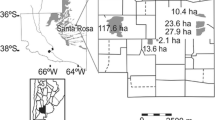Summary
The size of forest fragments, the use of land bordering fragments, and the distance of nests from an edge all affect the frequency of predation upon bird nests in Maine (USA), an area where the forest has been fragmented by roads, but not significantly reduced in area. We placed artificial nests containing quail eggs in forests of different sizes and at various distances from the edge to test which of these factors was most important in describing predation. Predation was greatest in small tracts surrounded completely by land. Large areas and those bordered on at least one side by a large water body had lower predation rates. This suggests that influx of predators from nearby habitats may be responsible for much of the nest predation in forest fragments.
Similar content being viewed by others
References
Ambuel B, Temple SA (1983) Area-dependent changes in tird communities and vegetation of southern Wisconsin forests. Ecology 64:1057–1068
Anderson TE (1971) Identifying, evaluating, and controlling wildlife damage. In: Giles RH Jr (ed) Wildlife management techniques, third edition. The Wildlife Society, Washington DC, pp 497–520
Brittingham MC, Temple SA (1983) Have cowbirds caused forest songbirds to decline? Bio Sci 33:31–35
Burgess KL, Sharpe DM (1981) Forest island dynamics in mandominated landscapes. Springer, Berlin Heidelberg New York
Dixon WJ (1983) BMDP statistical software: 1983 printing with additions. University of California Press, Berkeley
Forman RTT, Galli AE, Leck CF (1976) Forest size and avian diversity in New Jersey woodlots with some land use implications. Oecologia (Berlin) 26:1–8
Galli AE, Leck CF, Forman RTT (1976) Avian distribution patterns in forest islands of different sizes in central New Jersey. Auk 93:356–364
Gates JE, Gysel LW (1978) Avian nest dispersion and fledging success in field-forest ecotones. Ecology 59:871–883
Haila Y, Hanski I (1984) Methodology for studying the effect of fragmentation on land birds. Ann Zool Fenn 21:393–397
Harris LD (1984) The fragmented forest. University of Chicago Press, Chicago
Hoehne LM (1981) The groundlayer vegetation of forest islands in an urban-suburban matrix. In: Burgess RL, Sharpe DM (eds) Forest island dynamics in man-dominated landscape. Springer, Berlin Heidelberg New York, pp 41–54
Levenson JB (1981) Woodlots as biogeographic islands in southeastern Wisconsin. In: Burgess RL, Sharpe DM (eds) Forest island dynamics in man-dominated landscapes. Springer, Berlin Heidelberg New York, pp 13–39
Lovejoy TE, Bierregaard Jr. RO, Rylands AB, Malcolm JR, Quintela CE, Harper LH, Brown Jr KS, Powell AH, Powell GVN, Schubert HOR, Hays MB (1986) Edge and other effects of isolation on Amazon forest fragments. In: Soule M (ed) Conservation biology II. Sinauer, Sunderland Massachusetts, pp 257–285
Lynch JF, Whigham DF (1984) Effects of forest fragmentation on breeding bird communities in Maryland, USA. Biol Conserv 28:287–324
Matthiae PE, Stearns F (1981) Mammals in forest islands in southeastern Wisconsin. In: Burgess RL, Sharpe DM (eds) Forest island dynamics in man-dominated landscapes. Springer, Berlin Heidelberg New York, pp 55–66
Moore NW, Hooper MD (1975) On the number of bird species in British woods. Biol Conserv 8:239–250
Murphy DD, Wilcox BA (1986) Butterfly diversity in natural habitat fragments: A test of the validity of vertebrate-based management. In: Verner J, Morrison ML, Ralph CJ (eds) Wildlife 2000. University of Wisconsin Press, Madison, pp 287–292
Patton DR (1975) A diversity index for quantifying habitat “edge”. Wildl Soc Bull 3:171–173
Powell DS, Dickson DR (1984) Forest statistics for Maine: 1971 and 1982. USDA For Serv Resource Bull NE-81. p 194
Rosenburg KV, Raphael MG (1986) Effects of forest fragmentation on vertebrates in Douglas-fir forests. In: Verner J, Morrison ML, Ralph CJ (eds) Widlife 2000, University of Wisconsin Press, Madison, pp 263–272
Verner J, Morrison ML, Ralph CJ (1986) Widlife 2000. University of Wisconsin Press, Madison
Whitcomb RF, Robbins CS, Lynch JF, Whitcomb BL, Klimkiewicz MK, Bystrak D (1981) Effects of forest fragmentation on avifauna of the eastern deciduous forest. In: Burgess RL, Sharpe DM (eds) Forest island dynamics in man-dominated landscapes. Springer, Berlin Heidelberg New York, pp 125–205
Wilcove DS (1985) Nest predation in forest tracts and the decline of migratory songbirds. Ecology 66:1211–1214
Author information
Authors and Affiliations
Rights and permissions
About this article
Cite this article
Small, M.F., Hunter, M.L. Forest fragmentation and avian nest predation in forested landscapes. Oecologia 76, 62–64 (1988). https://doi.org/10.1007/BF00379601
Received:
Issue Date:
DOI: https://doi.org/10.1007/BF00379601




